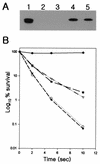Group I self-splicing intron in the recA gene of Bacillus anthracis
- PMID: 12081963
- PMCID: PMC135159
- DOI: 10.1128/JB.184.14.3917-3922.2002
Group I self-splicing intron in the recA gene of Bacillus anthracis
Abstract
Self-splicing introns are rarely found in bacteria and bacteriophages. They are classified into group I and II according to their structural features and splicing mechanisms. While the group I introns are occasionally found in protein-coding regions of phage genomes and in several tRNA genes of cyanobacteria and proteobacteria, they had not been found in protein-coding regions of bacterial genomes. Here we report a group I intron in the recA gene of Bacillus anthracis which was initially found by DNA sequencing as an intervening sequence (IVS). By using reverse transcriptase PCR, the IVS was shown to be removable from the recA precursor mRNA for RecA that was being translated in E. coli. The splicing was visualized in vitro with labeled free GTP, indicating that it is a group I intron, which is also implied by its predicted secondary structure. The RecA protein of B. anthracis expressed in E. coli was functional in its ability to complement a recA defect. When recA-negative E. coli cells were irradiated with UV, the Bacillus RecA reduced the UV susceptibility of the recA mutant, regardless of the presence of intron.
Figures




Similar articles
-
A functional homing endonuclease in the Bacillus anthracis nrdE group I intron.J Bacteriol. 2007 Jul;189(14):5293-301. doi: 10.1128/JB.00234-07. Epub 2007 May 11. J Bacteriol. 2007. PMID: 17496101 Free PMC article.
-
Housekeeping recA gene interrupted by group II intron in the thermophilic Geobacillus kaustophilus.Gene. 2005 Dec 19;363:211-20. doi: 10.1016/j.gene.2005.08.017. Epub 2005 Oct 19. Gene. 2005. PMID: 16242272
-
Evidence of selection for protein introns in the recAs of pathogenic mycobacteria.EMBO J. 1994 Feb 1;13(3):699-703. doi: 10.1002/j.1460-2075.1994.tb06309.x. EMBO J. 1994. PMID: 7508863 Free PMC article.
-
A self-splicing group I intron in the DNA polymerase gene of Bacillus subtilis bacteriophage SPO1.Cell. 1990 Oct 19;63(2):417-24. doi: 10.1016/0092-8674(90)90174-d. Cell. 1990. PMID: 2119891
-
Learning to live together: mutualism between self-splicing introns and their hosts.BMC Biol. 2011 Apr 11;9:22. doi: 10.1186/1741-7007-9-22. BMC Biol. 2011. PMID: 21481283 Free PMC article. Review.
Cited by
-
A functional homing endonuclease in the Bacillus anthracis nrdE group I intron.J Bacteriol. 2007 Jul;189(14):5293-301. doi: 10.1128/JB.00234-07. Epub 2007 May 11. J Bacteriol. 2007. PMID: 17496101 Free PMC article.
-
The Bacillus anthracis chromosome contains four conserved, excision-proficient, putative prophages.BMC Microbiol. 2006 Apr 6;6:34. doi: 10.1186/1471-2180-6-34. BMC Microbiol. 2006. PMID: 16600039 Free PMC article.
-
Group I Intron as a Potential Target for Antifungal Compounds: Development of a Trans-Splicing High-Throughput Screening Strategy.Molecules. 2023 May 31;28(11):4460. doi: 10.3390/molecules28114460. Molecules. 2023. PMID: 37298936 Free PMC article.
-
A matter of background: DNA repair pathways as a possible cause for the sparse distribution of CRISPR-Cas systems in bacteria.Philos Trans R Soc Lond B Biol Sci. 2019 May 13;374(1772):20180088. doi: 10.1098/rstb.2018.0088. Philos Trans R Soc Lond B Biol Sci. 2019. PMID: 30905287 Free PMC article.
-
Unusual group II introns in bacteria of the Bacillus cereus group.J Bacteriol. 2005 Aug;187(15):5437-51. doi: 10.1128/JB.187.15.5437-5451.2005. J Bacteriol. 2005. PMID: 16030238 Free PMC article.
References
-
- Cech, T. R. 1990. Self-splicing of group I introns. Annu. Rev. Biochem. 59:543-568. - PubMed
-
- Davies, R. W., R. B. Waring, J. A. Ray, T. A. Brown, and C. Scazzocchio. 1982. Making ends meet: a model for RNA splicing in fungal mitochondria. Nature 300:719-724. - PubMed
-
- Davis, E. O., P. J. Jenner, P. C. Brooks, M. J. Colston, and S. G. Sedgwick. 1992. Protein splicing in the maturation of M. tuberculosis RecA protein: a mechanism for tolerating a novel class of intervening sequence. Cell 71:201-210. - PubMed
Publication types
MeSH terms
Substances
LinkOut - more resources
Full Text Sources
Other Literature Sources

